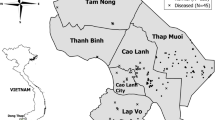Abstract
A survey of donkeys arriving at markets in three localities in East and West Shewa regions of central Ethiopia was carried out during 2002. Total faecal worm egg counts and body condition scores were measured for a total of 963 donkeys over a 12-month period. Total faecal worm egg counts did not differ significantly between localities but there was significant (p<0.001) seasonal variation within localities. Levels of helminth infection closely followed rainfall patterns, being lowest (956 eggs per gram of faeces, e.p.g.) at the end of the long dry season (February) and highest (2022 e.p.g.) in the middle of the long wet season (August). Body condition score was associated closely with level of helminth infection (Goodman-Kruskal measure of association 0.60–0.80). Seasonal variation in body condition score reflected the temporal changes in worm burden and the availability of forage. It is suggested that a body condition score of 3 or less could be used as a simple means of identifying donkeys that require therapeutic treatment with anthelmintic. It is further proposed that economically viable strategic control of helminths in donkeys could be achieved by administering a single annual dose of avermectin-based anthelmintic at the start of the long rainy season (May–June). This may allow donkeys to recover body condition when available forage is most abundant and nutritious. It is also recommended that protein-rich feed supplementation be provided during the later part of the dry season (November–January). This may help maintain body condition when forage is scarce and the helminth challenge is at its lowest.
Similar content being viewed by others
Abbreviations
- e.p.g.:
-
eggs per gram of faeces
- FEC:
-
faecal egg count
- GIT:
-
gastrointestinal tract
References
Agajie, T., Tamirat, D., Pearson, R.A. and Temesgen, T., 2000. Socio-economic circumstances of donkey use and management in the rural and urban areas of central parts of Ethiopia. In: D.G. Smith, T. Agajie and L. More (eds), Alleviating Poverty in Peri-Urban Ethiopia by Improving the Health, Welfare and Management of Donkeys, (Edinburgh, CTVM), 16–18
Coop, R.L. and Kyriazakis, L, 2001. Influence of host nutrition on the development and consequences of nematode parasitism in ruminants. Trends in Parasitology, 17, 325–330
Coop, R.L. and Holmes, P.H., 1996. Nutrition and parasite interaction. International Journal for Parasitology, 26, 951–962
Edwards, C.A., Atiyeh, R.M. and Rombke, J., 2001. Environment impact of avermectins. Reviews of Environmental Contamination and Toxicology, 171, 111–137
Feseha, G., Alemu, G., Friew, K., Abule, I. and Yilma, K., 1997. Donkey utilisation and management in Ethiopia. In: P. Starkey and D. Fielding (eds), Donkeys, People and Development. Animal Traction Network for Eastern and Southern Africa Workshop 5–9 May 1997, (ATNESA, Debre Zeit, Ethiopia), 46–52
Feseha, G., Mohamed. A. and Yilma, J., 1991. Vermicular endoparasitism in donkeys of Debre-Zeit and Menagesha, Ethiopia: strategic treatment with ivermectin and fenbendazole. In: D. Fielding and R.A. Pearson (eds), Donkeys, Mules and Horses in Tropical Agricultural Development, (CTVM, Edinburgh), 156–166
Hansen, J. and Perry, B.D., 1994. The Epidemiology, Diagnosis, and Control of Helminth Parasites of Ruminants: A Handbook, 2nd edn, (International Laboratory for Research on Animal Diseases, Nairobi, Kenya)
Kassai, T., 1999. Veterinary Helminthology, (Butterworth-Heinemann, Oxford)
Kianifard, F. and Chen, M., 1999. Extending Goodman-Kruskal's gamma to the comparison of ordered treatments in multicentre clinical trials. Journal of Biopharmaceutical Statistics, 9, 521–529
Matthee, S., Krecek, R.C., Milne, S.A., Boshoff, M. and Guthrie, A.J., 2002. Impact of management interventions on helminth levels, and body and blood measurements in working donkeys in South Africa. Veterinary Parasitology, 107, 103–113
Mengistu, A., Smith, D.G., Yoesph, S., Nega, T., Zewdie, W., Kassahun, W., Taye, B. and Firew, T., 2005. The effect of providing feed supplementation and anthelmintic to donkeys during late pregnancy and lactation on live weight and survival of dams and their foals in central Ethiopia. Tropical Animal Health and Production, 37(supplement), 000–000
Pandey, VS., Khallaayoune, K., Ouhelli, H. and Dakask, A., 1994. Parasites of donkeys in Africa. In: M. Bakkoury and R. Prentis (eds), Working Equines: Second International Colloquium, Rabat, Morocco, 20–22 April 1994 (Acles Editions, Rabat, Morocco), 35–44
Pearson, R.A. and Ouassat, M. 2000. A Guide to Live Weight Estimation and Body Condition Scoring of Donkeys, (CTVM, Edinburgh)
Pearson, R.A., 2000. Introduction to the project ‘Use and management of donkeys by poor societies in peri-urban areas in Ethiopia’. In: D.G. Smith, T. Agajie and L. More (eds), Alleviating Poverty in Peri-Urban Ethiopia by Improving the Health, Welfare and Management of Donkeys, (CTVM, Edinburgh), 2–5
Poynter, D., 1970. Some observations on the nematode parasites of horses. In: J.T. Bryans and H. Gerber (eds), Equine Infectious Diseases, Proceedings 2nd International Conference on Equine Infectious Diseases, Paris, 1969, (S. Karger, Basel), 269–289
Sloss, M., Kemp, R. and Zajac, A. 1994. Veterinary Clinical Parasitology, 6th edn, (Iowa State University Press, Ames, IA)
Soulsby, E., 1982. Helminths, Arthropods and Protozoa of Domestic Animals, 7th edn, (Balliere Tindall, London)
Yilma, J., Feseha, G., Svendsen, E. and Mohamed, A., 1991. Health problems of working donkeys in Debre Zeit and Menagesha of Ethiopia. In: D. Fielding and R.A. Pearson (eds), Donkeys, Mules and Horses in Tropical Development, (CTVM, Edinburgh), 151–166
Yoesph, S., Feseha, G. and Abebe, W., 2001. Survey on helminthiasis of equines in Wonchi, Ethiopia. Journal of the Ethiopian Veterinary Association, 5, 47–61
Author information
Authors and Affiliations
Corresponding author
Rights and permissions
About this article
Cite this article
Yoseph, S., Smith, D.G., Mengistu, A. et al. Seasonal Variation in the Parasite Burden and Body Condition of Working Donkeys in East Shewa and West Shewa Regions of Ethiopia. Trop Anim Health Prod 37 (Suppl 1), 35–45 (2005). https://doi.org/10.1007/s11250-005-9004-3
Issue Date:
DOI: https://doi.org/10.1007/s11250-005-9004-3




